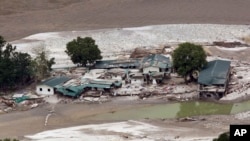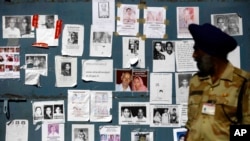NEW DELHI —
Indian air force officials are expressing optimism that about 5,000 people still stranded in the flood-hit mountains of northern India will be evacuated over the next few days. More than a week after the disaster struck, the focus is turning to providing relief to thousands of people displaced by the disaster.
Arriving in Uttarakhand state a day after an air force helicopter on a rescue mission crashed, killing 20 people, Indian Air Force chief N.A.K. Browne, said the “the rotors will not stop.”
“Literally, we are over the hump now," Browne said. "I think if we get three to four days of good weather, we should actually wrap it up in that period.”
More than 90,000 people have been rescued in the mountainous state, which was devastated by flash floods ten days ago after being lashed by the heaviest rainfall in 80 years. The massive mission has been led by air force and army personnel.
Tuesday’s helicopter accident highlighted how challenging that operation has been. The helicopter hit a steep hillside and crashed into a river.
Pilots have had to land their choppers on treacherous mountain terrain where there are no landing strips. Sorties have been carried out despite overcast skies, fog and rain in recent days. Army soldiers have raced to build makeshift tracks and rope bridges over raging rivers into towns and villages where all roads have been washed away.
There is no accurate estimate of the death toll. It has been tentatively placed at 1,000, but officials say it could be much higher. Officials says it is difficult to estimate how many people are still waiting for help.
“Just as we think that we have finished in a certain area, we find many of the people the next day the numbers have increased because villagers are still stuck on the mountains," Browne said, "so they are coming down, but we will take it from day to day.”
The focus is now moving from rescue to providing relief for those who have lost their homes in the disaster.
A number of those caught in the disaster were Hindu devotees visiting four famous Hindu pilgrim sites in the state.
But with villages and small towns suffering widespread devastation, the local population has been badly hit, and is in need of food, clean water and medical help. Aid workers are trying to reach remote settlements, but with communication links heavily damaged, access to many areas poses a problem.
Aid agencies have also warned of the threat of epidemics if those who died in the disaster are not cremated soon. But bad weather has hampered plans to transport priests and firewood for mass cremations to Kedarnath, a pilgrim site where many bodies have been found.
Arriving in Uttarakhand state a day after an air force helicopter on a rescue mission crashed, killing 20 people, Indian Air Force chief N.A.K. Browne, said the “the rotors will not stop.”
“Literally, we are over the hump now," Browne said. "I think if we get three to four days of good weather, we should actually wrap it up in that period.”
More than 90,000 people have been rescued in the mountainous state, which was devastated by flash floods ten days ago after being lashed by the heaviest rainfall in 80 years. The massive mission has been led by air force and army personnel.
Tuesday’s helicopter accident highlighted how challenging that operation has been. The helicopter hit a steep hillside and crashed into a river.
Pilots have had to land their choppers on treacherous mountain terrain where there are no landing strips. Sorties have been carried out despite overcast skies, fog and rain in recent days. Army soldiers have raced to build makeshift tracks and rope bridges over raging rivers into towns and villages where all roads have been washed away.
There is no accurate estimate of the death toll. It has been tentatively placed at 1,000, but officials say it could be much higher. Officials says it is difficult to estimate how many people are still waiting for help.
“Just as we think that we have finished in a certain area, we find many of the people the next day the numbers have increased because villagers are still stuck on the mountains," Browne said, "so they are coming down, but we will take it from day to day.”
The focus is now moving from rescue to providing relief for those who have lost their homes in the disaster.
A number of those caught in the disaster were Hindu devotees visiting four famous Hindu pilgrim sites in the state.
But with villages and small towns suffering widespread devastation, the local population has been badly hit, and is in need of food, clean water and medical help. Aid workers are trying to reach remote settlements, but with communication links heavily damaged, access to many areas poses a problem.
Aid agencies have also warned of the threat of epidemics if those who died in the disaster are not cremated soon. But bad weather has hampered plans to transport priests and firewood for mass cremations to Kedarnath, a pilgrim site where many bodies have been found.








